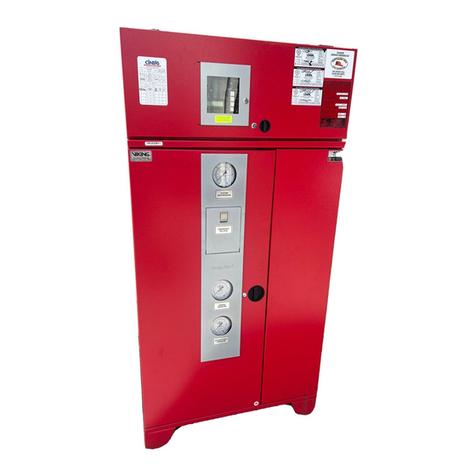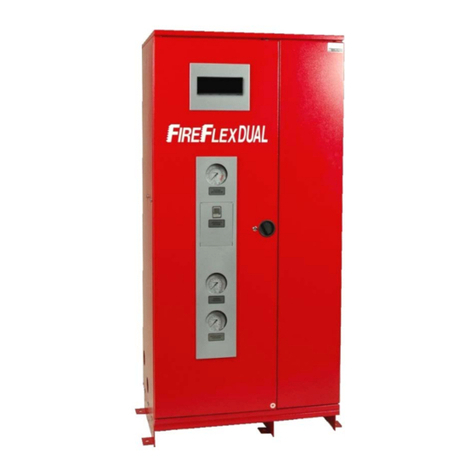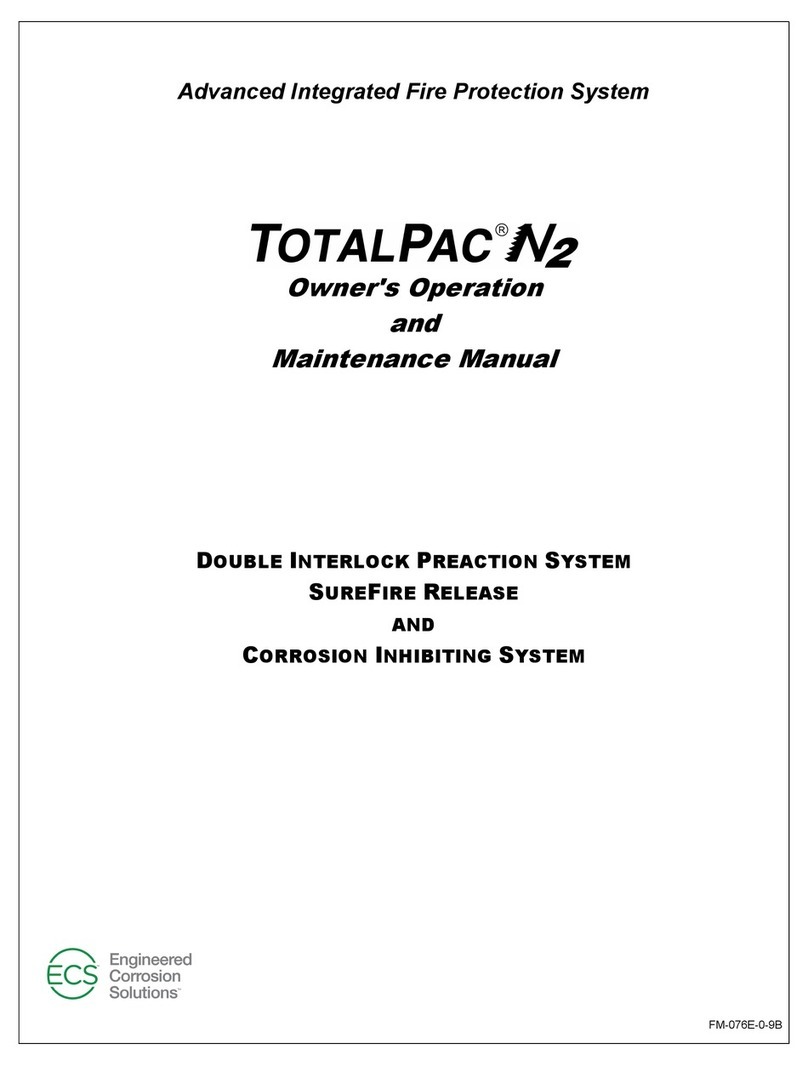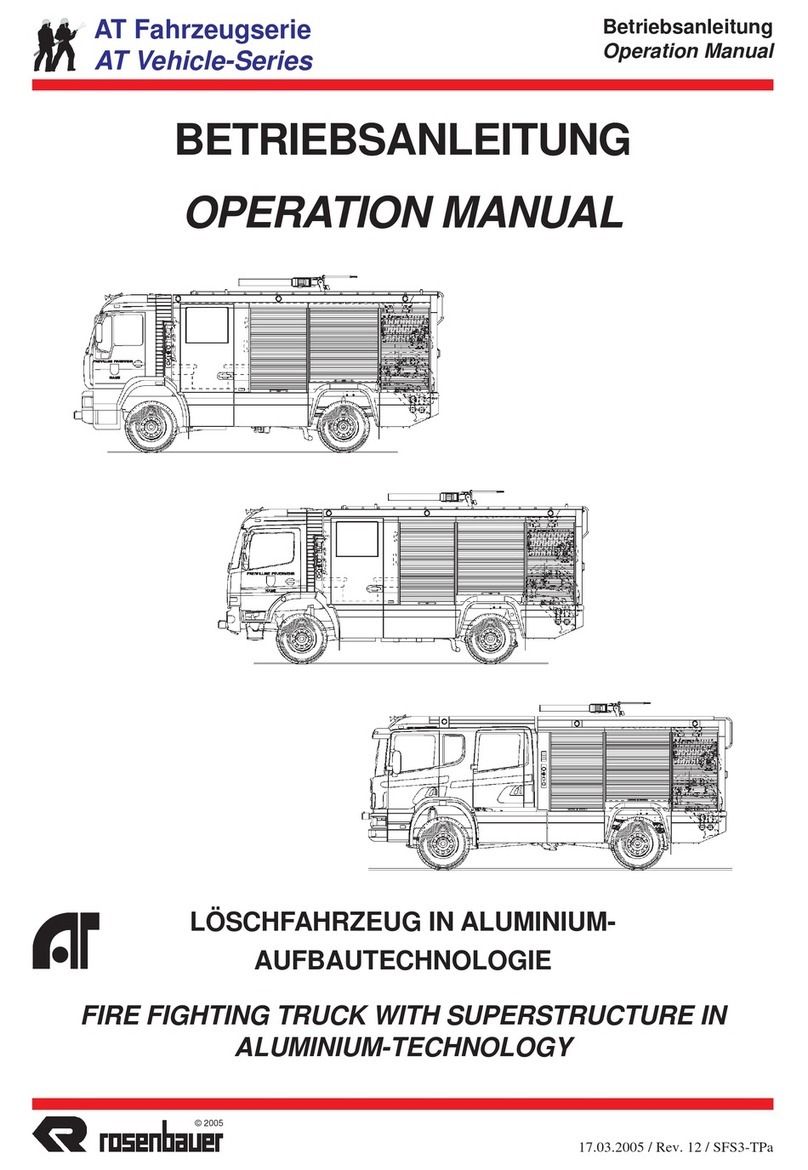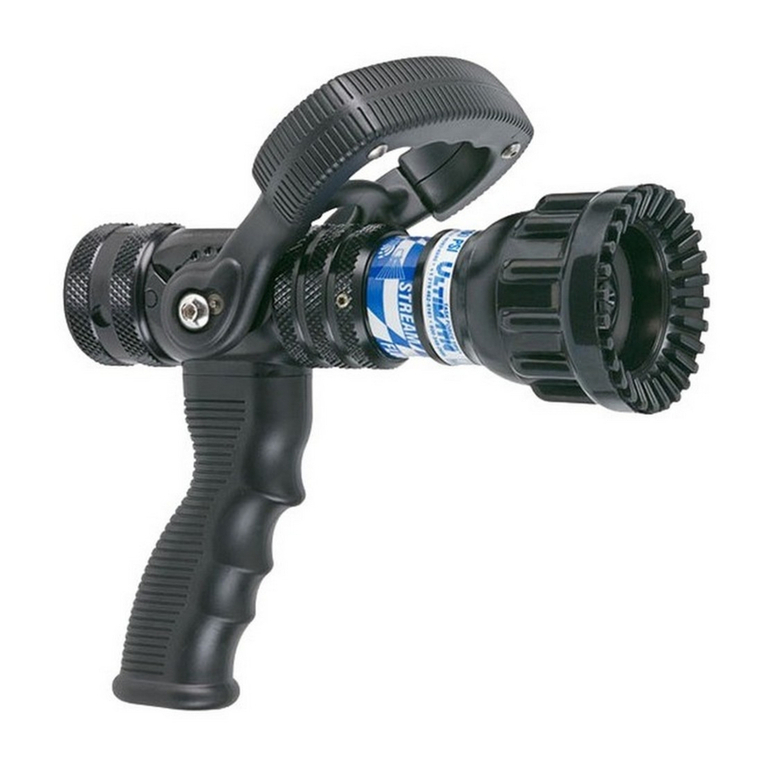FireFlex 1230 Installation guide

FM-0860-0-10J
Integrated Fire Protection System
®1230
Owner's Operation and Maintenance Manual
Self-contained system

Page ii ®1230
Integrated Fire Protection System
OWNER'S OPERATION &MAINTENANCE MANUAL
FM-0860-0-10J
Copyright©2009-2016
FIREFLEX Systems Inc
.
All Rights Reserved
Reproduction or use, without express written permissionfrom FIREFLEX Systems Inc, of any portion of this manual is prohibited. While
all reasonable efforts have been taken in the preparation of this manual to assure its accuracy, FIREFLEX Systems Inc assumes no
liability resulting from any errors or omissions in this manual, or from the use of the information contained herein. FIREFLEX®1230 is
a registered trademark of FIREFLEX Systems Inc.
FIREFLEX Systems Inc. reserves the right to make changes to this manual and the data sheets herewith at any time, without prior
notification.

®1230 Page iii
Integrated Fire Protection System
OWNER'S OPERATION &MAINTENANCE MANUAL
FM-0860-0-10J
Table of Contents
1. GENERAL.....................................................................................................................................................................1
1.1 APPLICABLE STANDARDS...................................................................................................................................................1
1.2 LISTINGS & APPROVALS......................................................................................................................................................1
1.3 ENVIRONMENT .....................................................................................................................................................................1
1.4 GENERAL DESCRIPTION .....................................................................................................................................................1
1.5 FEATURES.............................................................................................................................................................................2
1.6 CONFIGURATION..................................................................................................................................................................2
1.7 RELEASING ...........................................................................................................................................................................2
1.8 ABORT....................................................................................................................................................................................2
2. CLEAN EXTINGUISHING AGENT...............................................................................................................................6
2.1 AGENT....................................................................................................................................................................................6
2.2 DESCRIPTION .......................................................................................................................................................................6
2.3 ENVIRONMENTAL.................................................................................................................................................................6
2.4 SAFETY CONSIDERATIONS.................................................................................................................................................6
3. INSTALLATION, OPERATION & MAINTENANCE INSTRUCTIONS..........................................................................7
3.1 INSTALLATION ......................................................................................................................................................................7
3.2 PRELIMINARY INSPECTION.................................................................................................................................................7
3.3 PLACING SYSTEM IN SERVICE...........................................................................................................................................7
3.4 SEQUENCE OF OPERATION................................................................................................................................................8
3.5 EMERGENCY INSTRUCTIONS.............................................................................................................................................9
3.6 PLACING THE SYSTEM BACK IN SERVICE AFTER OPERATION......................................................................................9
3.7 ELECTRIC ACTUATOR..........................................................................................................................................................9
3.8 INSPECTIONS & TESTS......................................................................................................................................................10
3.9 MAINTENANCE....................................................................................................................................................................10
4. CONTROLS................................................................................................................................................................11
4.1 PRODUCT DESCRIPTION...................................................................................................................................................11
4.2 PFC-4410RC RELEASE CONTROL PANEL........................................................................................................................11
4.3 PFC-4410RC VISUAL INDICATORS....................................................................................................................................11
4.4 PFC-4410RC CONTROL BUTTONS....................................................................................................................................11
4.5 TIME AND DATE SETTINGS ...............................................................................................................................................12
5. PROGRAMMING & WIRING DIAGRAMS..................................................................................................................14
5.1 FIREFLEX®1230 PROGRAMMING.......................................................................................................................................14
5.2 FIREFLEX®1230 WIRING DIAGRAMS..................................................................................................................................15
6. CABINET.....................................................................................................................................................................16
7. LIMITED WARRANTY................................................................................................................................................18

Page iv ®1230
Integrated Fire Protection System
OWNER'S OPERATION &MAINTENANCE MANUAL
FM-0860-0-10J
THIS PAGE IS LEFT BLANK INTENTIONALLY.

®1230 Page 1 of 18
Integrated Fire Protection System
OWNER'S OPERATION &MAINTENANCE MANUAL
FM-0860-0-10J
1. GENERAL
The FIREFLEX®1230 integrated system consists of a clean
agent fire extinguishing system, factory-assembled in a single
cabinet. All the components necessary for the extinguishing
system are integrated.
The FIREFLEX®1230 system uses 3M™ NOVEC™ 1230 fire
protection fluid. The clean extinguishing agent is based on
sustainable technology and is the only chemical agent
currently available that meets the most stringent actual and
future environmental standards.
1.1 APPLICABLE STANDARDS
In addition to being fabricated under stringent ISO-9001
manufacturing and quality control procedures, your
FIREFLEX®1230 complies with the following standards:
NFPA-70 National Electrical Code
NFPA-72 Fire Alarm Systems
NFPA-2001 Clean agent fire extinguishing system
Before the installation, the contractor installing the unit shall
also be familiar with the following documents and standards:
Applicable Local & State Building Codes
Any additional requirements of the Local Authority Having
Jurisdiction
1.2 LISTINGS & APPROVALS
- Approbation Factory Mutual: FIREFLEX®1230 systems
are FM Approved under the heading: "FIXED
EXTINGUISHING SYSTEMS, CLEAN AGENT FIRE
EXTINGUISHING SYSTEMS".
- Underwriters Laboratories Inc. (UL): FIREFLEX®1230
Systems are UL Listed under "Clean Agent Extinguishing
System Unit” Category # GAQF-EX6174 and Category
# GAQFC-EX6174 (ULC).
Warning ! Any unauthorized modification or addition made
on-site to a factory built Listed Unit will void this Listing.
Such modifications or additions may void the unit's
warranty as well. Consult your nearest FIREFLEX
Systems Authorized Distributor before proceeding with
such modifications or additions.
1.3 ENVIRONMENT
FIREFLEX®1230 unit shall be installed in a dry and clean
location. Verify that all equipments are properly heated and
protected to prevent freezing and physical damage.
The unit and its components must be kept free of foreign
matter, freezing conditions, corrosive atmospheres,
contaminated water supplies, and any condition that could
impair its operation or damage the components.
The frequency of the inspections and maintenance will vary
depending on the environmental conditions.
The owner is responsible for maintaining the fire protection
system and devices in proper operating condition (refer to
section 3)
1.4 GENERAL DESCRIPTION
The FIREFLEX®1230 system uses SEVO®cylinders designed
for a high volume discharge rate in order to meet the rapid
discharge requirements specified in the NFPA-2001 Standard.
Discharge valves are of brass construction and are designed
as per the pressure differential concept. They are equipped
with a pressure-indicating gauge and an electric or pneumatic
actuator. Each cylinder is also provided with an integrated
pressure safety device.
FIREFLEX®1230 system is engineered by FIREFLEX Systems
Inc. (or an authorized contractor) to meet the specific
protection requirements of the application for which it is being
installed.
Each system is designed per NFPA-2001 Standard and in
compliance with instructions found in the following
manufacturer design manuals:
•SEVO Design Manual: SE 1230 500 ENG (latest rev.)
•Potter PFC-4410RC Manual #5403550 (latest rev.)
The cylinders are filled with the extinguishing agent and then
pressurized to 500 Psi at 70°F (34.5 bar at 21.1°C) with
Nitrogen allowing maximum flexibility at the time of installation.
Each cylinder is fabricated, tested and stamped according to
D.O.T. 4BA500 or 4BW500 or TPED specifications depending
on its size and capacity.
The FIREFLEX®1230 cabinet is of the free-standing type and
is made of robust 14 gauge steel with a rustproof fire red paint
finish, polyester powder coated and oven baked on a
phosphate base. Each cabinet is provided with oneor two
frontal locked doors, reducing space requirements for ease of
installation and maintenance. Furthermore, all doors are
provided with a neoprene gasket to reduce vibrations.
Table 1.1 - FIREFLEX®1230 capacity of cabinet
(cylinder quantity)
Cabinet
width Size of cylinder (lbs)
40 76 164 322 601 850
24" 1 1 1 1 1 n/a
36" 2 2 2 n/a n/a n/a
46" n/a n/a n/a 2 2 n/a
54" n/a n/a n/a n/a n/a 1 - 2

Page 2 of 18 ®1230
Integrated Fire Protection System
OWNER'S OPERATION &MAINTENANCE MANUAL
FM-0860-0-10J
1.5 FEATURES
FIREFLEX®1230 main features are:
•Trouble-free design for safe and easy application
•Compact, aesthetic and easy to move
•Available in 4 cabinet sizes
•User-friendly standardized owner's manual with every unit
•Unique serial number on every unit
•Uses UL, ULC and/or FM Approved components
•Designed in accordance with NFPA Standards
•Completely assembled and checked in factory
•Sturdy 14 gauge steel cabinet painted fire red with oven
baked polyester powder on phosphate base
•Textured rust proof finish
•Neoprene gasket on all doors to eliminate vibrations
•Key-alike locks on all cabinet doors
•Manufactured under ISO-9001 quality control procedures
1.6 CONFIGURATION
Configurations for FIREFLEX®1230:
•Engineered NOVEC 1230 single cylinder with electric
release
•Engineered NOVEC 1230 double cylinder with Main /
Reserve
•Engineered NOVEC 1230 double cylinder with Master /
Slave
1.7 RELEASING
1.7.1 Electric releasing conditions
The electric releasing condition is needed in order to operate
the electric actuator (C) of the NOVEC 1230. It can be
achieved as the following:
a) Single zone detection activated by either Zone 1 or
Zone 2.
b) Cross zone detection activated by both Zone 1 and
Zone 2.
c) Manual pull station activated by Zone 4.
1.7.2Electric release
See figure 1.1.
Electric release is achieved with an electric actuator (C)
installed on the discharge valve (B) of the cylinder (A). When
the releasing conditions are fulfilled,a 24Vdc source is applied
to the electric actuator (C) thereby venting the pressureon top
of the discharge valve (B) thus allowing the extinguishing
agent NOVEC 1230 to be discharged through the piping and
nozzles.
1.7.3Double cylinder with electric release with
Main / Reserve switch
See figure 1.2.
A switch allows operation of electric release on Main
cylinder (A) and then Reserve cylinder.
1.7.4Double cylinder with electric release on Master
cylinder and pneumatic actuator on Slave cylinder
See figure 1.3.
Electric release is achieved on Master cylinder (A).
On the Slave cylinder, the electric actuator (C) is replaced with
a pneumatic actuator (K), which is driven by the Master
cylinder (A) discharge pressure.
1.8ABORT
When abort release switch is activated, pre-discharge timer
will continue to count down until it reaches 10 seconds and
then wait. Releasing the abort release switch will allow the
pre-discharge to continue its count down from 10 seconds. If
the abort release switch is again activated before the pre-
discharge timer reaches zero, the timer will reset to
10 seconds and wait.
CAUTION ! Abort does not function and has no effect on
panel operation from zones programmed as Manual
RELEASE.

®1230 Page 3 of 18
Integrated Fire Protection System
OWNER'S OPERATION &MAINTENANCE MANUAL
FM-0860-0-10J
Figure 1.1 - Single NOVEC 1230 cylinder with electric release
Components:
A Cylinder
B Cylinder valve
C Electric actuator
D Pressure gauge c/w Low cylinder pressure switch
E Liquid level indicator
F Bracket
G Discharge pressure switch (optional)
H Mechanical actuator (optional)
A
E
C
H
B
D
Field connection to
NOVEC 1230 piping
F
F
FM-076Z-0-15C-1
F
IRE
F
LEX
1230 base
(shown without enclosure)

Page 4 of 18 ®1230
Integrated Fire Protection System
OWNER'S OPERATION &MAINTENANCE MANUAL
FM-0860-0-10J
Figure 1.2 - Double NOVEC 1230 cylinder with Main / Reserve
Components:
A Main cylinder (Reserve is the right one)
B Cylinder valve
C Electric actuator
D Pressure gauge c/w Low cylinder pressure switch
E Liquid level indicator
F Bracket
G Discharge pressure switch (optional)
H Mechanical actuator (optional)
A
E
C
D
B
H
C
HD
Field connection to
NOVEC 1230 piping
F
F
F
F
E
G
G
FM-076Z-0-15C-2
FIREF
LEX
1230 base
(shown without enclosure)

®1230 Page 5 of 18
Integrated Fire Protection System
OWNER'S OPERATION &MAINTENANCE MANUAL
FM-0860-0-10J
Figure 1.3 - Double NOVEC 1230 cylinder with Master / Slave
Components:
A Master cylinder (Slave is the left one)
B Cylinder valve
C Electric actuator
D Pressure gauge c/w Low cylinder pressure switch
E Liquid level indicator
F Bracket
G Discharge pressure switch (optional)
H Mechanical actuator (optional)
J Pneumatic actuator
A
G
E
C
D
B
H
J
D
ECopper tubing
Field connection to
NOVEC 1230 piping
FM-076Z-0-15C-3
F
F
F
F
G
FIREFLEX 1230 base
(shown without enclosure)

Page 6 of 18 ®1230
Integrated Fire Protection System
OWNER'S OPERATION &MAINTENANCE MANUAL
FM-0860-0-10J
2. CLEAN EXTINGUISHING AGENT
2.1 AGENT
The clean extinguishing agent used in FIREFLEX®1230 total
flooding system is NOVEC 1230.
Note: The term NOVEC 1230 employed throughout this
manual refers to the extinguishing agent Dodecafluoro-2-
methylpentan-3-one known as SEVO 1230 Fire
Protection Fluid (also known as FK-5-1-12, 3M™
NOVEC™ 1230 Fire Protection Fluid, C6-F-ketone)
produced by 3M™.
2.2 DESCRIPTION
NOVEC 1230 is a colorless fluid. It is stored as a pressurized
liquid and injected into a room, area, or compartment that has
the structural integrity to retain the agent that has been
discharged.
NOVEC 1230 is dispensed as an odorless, electrically non-
conductive vapor. It leaves no residue.
NOVEC 1230 is a clean, efficient fire-extinguishing agent that
can be used on Class A, B, or C fires. It is a very stable, inert
and electrically non-conductive gas. Its primary use is for
energized electric equipment fire containment and preventing
reigniting.
2.3 ENVIRONMENTAL
NOVEC 1230 does not contribute to depletion of the
stratospheric ozone layer. NOVEC 1230 has an atmospheric
lifetime of 0.014 years. Its global warming potential is 1.
2.4 SAFETY CONSIDERATIONS
2.4.1 TOXICITY
The table 2.1 identifies the toxicological data on NOVEC 1230
and compares this with HALON 1301.
Table 2.1 - Toxicological data
NOVEC 1230 HALON 1301
No Observed Adverse
Effect Level (NOAEL) 10% 5.0%
Low Observed Adverse
Effect Level (LOAEL) 10% 7.5%
Acute Exposure LC50
(4 hour rate - ppm) 100,000 800,000
Design Concentration
(minimum) 4.455% 4.3%
2.4.2 NOISE
Discharge of a NOVEC 1230 system can cause noise loud
enough to be startling but ordinarily insufficient to cause
traumatic injury.
2.4.3 TURBULENCE
High velocity discharge from nozzles may be sufficient to
dislodge substantial objects directly in the path of the
discharge. General turbulence in the enclosure may be
sufficient to move light objects, unsecured paper, etc. Ceiling
tiles in the vicinity of the nozzles should be clipped in place to
prevent them from being dislodged during the discharge.
2.4.4 COOLING
Direct contact with vaporizing liquid NOVEC 1230 will have a
strong chilling effect on objects and can cause frostbite burns
to the skin. The liquid phase vaporizes rapidly when mixed
with air and thus limits the hazard to the immediate vicinity of
the discharge nozzle.
2.4.5 VISIBILITY
Upon discharge reduced visibility will be evident, especially in
humid atmospheres, as a result of the condensations of vapor.
The period of reduced visibility will normally be brief.
2.4.6 PRESSURE
The discharge nozzle is between
73 Psi and 290 Psi (5 bar and 20 bar).

®1230 Page 7 of 18
Integrated Fire Protection System
OWNER'S OPERATION &MAINTENANCE MANUAL
FM-0860-0-10J
3. INSTALLATION, OPERATION & MAINTENANCE INSTRUCTIONS
3.1 INSTALLATION
IMPORTANT ! The FIREFLEX®1230 unit IS NOT
designed to be installed in area subject to freezing
conditions. Refer to section 1.3 ENVIRONMENT for
additional details.
1. Install the FIREFLEX®1230 cabinet (refer to section 6
CABINET).
IMPORTANT ! THE CABINET MUST BE FIRMLY
ANCHORED TO THE FLOOR USING ALL FOUR (4)
ANCHORING HOLES.
2. Install the clean agent releasing piping, detection and
signaling circuits (if applicable) in accordance with
applicable standards.
3. Connect all detection and alarm audible devices, where
applicable, according to electrical schematics (refer to
section 5.2).
4. Connect the AC power for the release control panel on a
separate breaker in the electric distribution panel (refer
to section 5.2).
5. Conform to local municipal or other codes regarding
installations of fire protection systems.
6. Place the FIREFLEX®1230 system in service (refer to
chapters 3.2).
7. If the system does not operate as it should, make the
necessary corrections according to manuals issued or
consult your distributor or FIREFLEX Systems Inc.
8. Make sure that building owner or a delegated
representative has received instructions regarding the
operation of the system.
3.2 PRELIMINARY INSPECTION
See figure 1.1, 1.2 or 1.3.
1. FIREFLEX®1230 cabinet shall be firmly anchored to the
floor.
2. Open door to mechanical section.
3. Each cylinder (A) shall be solidly fixed with brackets (F).
4. Check the pressure of each cylinder with pressure
gauge (D) according to table 3.1. If the cylinder shows
a loss in pressure of more than 10%, it shall be refilled
or replaced.
5. Check that piping supports have been installed at the
correct intervals and are adequate for the purpose.
6. The piping distribution system shall be inspected to
determine that it is in compliance with the design and
installation documents.
7. Nozzles and pipe size shall be in accordance with
system drawings. Means of pipe size reduction and
attitudesof tees shall be checked forconformance to the
design.
8. Check that all nozzles are fitted in accordance with the
design requirements and are aimed in the correct
alignment away from obstructions or barriers that could
prevent adequate distribution/mixing of the gas.
9. Protected area Integrity test shall be considered to locate
and then effectively seal any significant air leaks that
could result in a failure of the enclosure to hold the
specified agent concentration level for the specified
holding period. The currently preferred method is using
a blower door fan unit and smoke pencil.
3.3 PLACING SYSTEM IN SERVICE
1. Check all detectors.
2. Check all manual pull stations.
3. Check all audible & visual devices.
4. Check if extinguishments electric actuator (C) operates
after preset time delay.
5. Simulate a low cylinder pressure by shorting low cylinder
pressure switch (D) terminals.
6. Verify the active installation supervision switch on the
electric actuator (C).
CAUTION ! Activate the releasing circuit disable switch
before doing any tests on the system (see figure 4.2).
7. Perform sequence of operation (refer to chapter 3.4).
Table 3.1 - Cylinder pressure versus temperature
Cylinder pressure Temperature
413 psi
(28.4 bar)
0°F
(-17.8°C)
425 psi
(29.3 bar)
10°F
(-12.2°C)
438 psi
(30.1 bar)
20°F
(-6.67°C)
450 psi
(31 bar)
32°F
(0°C)
463 psi
(31.9 bar)
40°F
(4.4°C)
475 psi
(32.7 bar)
50°F
(10°C)
488 psi
(33.6 bar)
60°F
(15.6°C)
500 psi
(34.5 bar)
70°F
(21.2°C)
513 psi
(35.3 bar)
80°F
(26.7°C)
525 psi
(36.2 bar)
90°F
(32.2°C)
538 psi
(37 bar)
100°F
(37.8°C)
550 psi
(37.9 bar)
110°F
(43.3°C)
563 psi
(38.8 bar)
120°F
(48.9°C)

Page 8 of 18 ®1230
Integrated Fire Protection System
OWNER'S OPERATION &MAINTENANCE MANUAL
FM-0860-0-10J
3.4 SEQUENCE OF OPERATION
3.4.1 Automatic release
1. Actuation of a detector from one detection zone:
a) "COMMON ALARM" lamp flashes.
b) "ZONE 1" (or "ZONE 2") lamp flashes.
c) "DETECTION ZONE 1" (or "DETECTION ZONE 2")
message appears on the display.
d) "OUTPUT 1" (1ST ALARM) activates.
e) "ALARM" contact activates.
2. Actuation of a detector from the other detection zone for
crossed zones configuration):
a) "ZONE 2" (or "ZONE 1") lamp flashes.
b) "DETECTION ZONE 2" (or "DETECTION ZONE 1")
message appears on the display.
3. Pre-discharge sequence occurs:
a) "PRE-DISCHARGE" lamp flashes.
b) "OUTPUT 2" (2ND ALARM) activates.
c) Pre-discharge delay starts (not exceeding 60 sec).
Note: The abort station will prevent the NOVEC 1230
discharge as long as being maintained if activated during
the pre-discharge delay (refer to chapter 3.4.3).
4. After pre-discharge delay is completed:
a) "DISCHARGING" lamp illuminates steady.
b) "OUTPUT 4" lamp flashes.
c) "OUTPUT 4" (RELEASING) message appears on the
display.
d) NOVEC 1230 electric actuator (C) activates.
If NOVEC 1230 discharge switch option is selected:
e) "ZONE 3" lamp flashes.
f) "DETECTION ZONE 3" (RELEASING) message
appears on the display.
g) "RELEASING" contact activates.
3.4.2 Manual release
1. Actuation of a manual release pull station within the
system:
a) "COMMON ALARM" lamp flashes.
b) "ZONE 4" lamp flashes.
c) "PRE-DISCHARGE" lamp flashes.
d) "DETECTION ZONE 4" (MANUAL RELEASE) message
appears on the display.
e) "OUTPUT 2" (2ND ALARM) activates.
f) "ALARM" contact activates.
g) Pre-discharge delay starts (not exceeding 30 sec).
2. After pre-discharge delay is completed:
a) "DISCHARGING" lamp illuminates steady.
b) "OUTPUT 4" lamp flashes.
c) "OUTPUT 4" (RELEASING) message appears on the
display.
d) NOVEC 1230 electric actuator (C) activates.
If NOVEC 1230 discharge switch option is selected:
e) "ZONE 3" lamp flashes.
f) "DETECTION ZONE 3" (RELEASING) message
appears on the display.
g) "RELEASING" contact activates.
Note: At any time, if the optional mechanical activator (J)
is activated, the NOVEC 1230 will be released.
3.4.3 Abort Station
1. Actuation of an abort station within the system:
a) "SYSTEM TBL" lamp flashes.
b) " SUP 1 / ABORT " lamp flashes.
c) "TROUBLE ABORT" message appears on the display.
d) "TROUBLE” contact activates.
When abort release switch is activated, pre-discharge timer
will continue to count down until it reaches 10 seconds and
then wait. Releasing the abort release switch will allow the
pre-discharge to continue its count down from 10 seconds. If
the abort release switch is again activated before the pre-
discharge timer reaches zero, the timer will reset to
10 seconds and wait.
CAUTION ! Abort does not function and has no effect on
panel operation from zones programmed as Manual
RELEASE.
3.4.4System supervisory
1. Actuation of a supervisory device such as low pressure
switch within the system:
a) "SUPERVISORY 2" lamp flashes.
b) "SUPERVISORY 2" message appears on the display.
c) "SUPERVISORY” contact activates.

®1230 Page 9 of 18
Integrated Fire Protection System
OWNER'S OPERATION &MAINTENANCE MANUAL
FM-0860-0-10J
3.5 EMERGENCY INSTRUCTIONS
To take system out of service:
WARNING ! Placing a system out of service may eliminate
the fire protection capabilities of the system. Prior to
proceeding, notify all Authorities Having Jurisdiction.
Consideration should be given to employ a fire patrol in
the affected areas.
After placing the system out of servicehas been authorized by
the appropriate Authority Having Jurisdiction:
1. Turn the releasing circuit disable switch to
DISABLED before doing any tests on the system (see
figure 4.2).
2. To return the system back in service, turn the releasing
circuit disable switch to NORMAL (see figure 4.2).
3.6 PLACING THE SYSTEM BACK IN SERVICE AFTER
OPERATION
See figure 1.1, 1.2 or 1.3.
1. Remove the electric actuator (C) from the cylinder (A).
2. Remove cylinders and send it to an authorized agent for
filling.
3. Reinstall the cylinders inside the cabinet.
4. Reset the electric actuator (C) (refer to chapter 3.7).
5. Install the electric actuator (C) on the cylinder (A).
6. Check that the piping and nozzles have not been altered.
WARNING ! the optional mechanical release (J) SHALL
be in NORMAL position, handle upwards and safety pin
installed BEFORE installing it on the cylinder valve (B).
7. Notify the Authority Having Jurisdiction, remote station
alarm monitors, and those in the affected area that the
system is back in service.
3.7 ELECTRIC ACTUATOR
When the electric actuator (C) gets energized, it stays in the
activated position (see figure 3.1).
Figure 3.1
Reset the actuator (C) to normal position by turning or pushing
the resetting tool (see figures 3.2 & 3.3).
Figure 3.2
Figure 3.3
Activated position
Resetting tool
Normal position

Page 10 of 18 ®1230
Integrated Fire Protection System
OWNER'S OPERATION &MAINTENANCE MANUAL
FM-0860-0-10J
3.8 INSPECTIONS & TESTS
NOTICE:THE OWNER IS RESPONSIBLE FOR
MAINTAINING THE FIRE PROTECTION SYSTEM AND
DEVICES IN PROPER OPERATING CONDITION.
The purpose of the periodic inspection and tests is to insure
that the system is operating satisfactory and to identify
problems that could adversely affect the performance of the
system. Inspection and tests of the system shall be
accomplished in accordance with NFPA-25, NFPA-72 and
NFPA-2001. At least annually, the system shall be thoroughly
inspected and tested for proper operation by competent
personnel. In addition, the Authority Having Jurisdiction may
have additional maintenance, testing, and inspection
requirements that must be followed.
WARNING ! Any system maintenance that involves
placing the system out of service may eliminate the fire
protection capabilities of that system. Prior to proceeding,
notify all Authorities Having Jurisdiction.
Records
Records of inspections, tests, and maintenance of the system
and its components shall be made available to the Authority
Having Jurisdiction upon request. Typical records include, but
are not limited to, detection system, and NOVEC 1230 cylinder
inspections.
Acceptance test records should be retained for the life of the
system. Subsequent test records should be retained for a
period of 1 year after the next test. The comparison
determines deterioration of system performance or condition
and the need for further testing or maintenance.
3.8.1Monthly inspection
1. Visually inspect all NOVEC 1230 system components
and cylinder pressure.
2. Refer any noted problems or deficiencies to authorized
service personnel for correction.
3.8.2Semi-annual inspection
1. Check the nozzles piping for corrosion and damage.
2. Check all piping supports to insure they are tight and
properly secured.
3. Check the discharge nozzle orifice(s) to see if they are
clear with no obstructions.
4. Check to insure that the nozzles arepositioned correctly.
7. Check the quantity of liquid and pressure in each
cylinder (A). If a loss in net weight of more than 5% or a
loss in pressure of more than 10% (refer to table 3.1), it
shall be refilled or replaced.
6. Perform functional test of all components of the system.
WARNING ! Prior to any functional tests, the actuator (C)
must be removed to prevent cylinder (A) discharge.
3.8.3 Annual inspection
1. Perform semi-annual inspection.
2. Check all detectors.
3. Check all manual pull stations.
4. Check all audible & visual devices.
5. Check all HVAC shut down, etc.
6. Check if extinguishment electric actuator (C) operates
after pre-discharge delay.
7. Simulate a low pressure of cylinder (A) by shorting low
cylinder pressure switch (D) terminals.
8. Perform sequence of operation (refer to chapter 3.4).
3.9 MAINTENANCE
The system shall be maintained in full operation condition at
all times.
All troubles or impairments shall be corrected promptly
consistent with the hazard being protected.
Any penetration made through the enclosure protected by the
clean agent shall be sealed immediately. The method of
sealing shall restore the original fire resistance rating of the
enclosure.

®1230 Page 11 of 18
Integrated Fire Protection System
OWNER'S OPERATION &MAINTENANCE MANUAL
FM-0860-0-10J
4. CONTROLS
4.1 PRODUCT DESCRIPTION
The release control panel of the FIREFLEX®1230 system is
an add-on unit that is installed inside the cabinet at the factory.
Once the left door opened, the locked control panel door can
be opened to give access to the control panel keyboard, the
emergency battery compartment, and other related
equipment.
The releasing circuit disabled switch of the NOVEC 1230 is
located at left of the release control panel.
The control panel can be easily flipped once unlatched from
the right side, giving access to electrical junction boxes of the
unit (refer to figure 5.1 for additional details).
4.2 PFC-4410RC RELEASE CONTROL PANEL
The Potter model PFC-4410RC releasing control panel is an
approved and listed microprocessor based unit, primarily
designed for use as a releasing panel. The panel is available
for use with 120VAC, 60Hz or 220VAC, 50/60Hz main power
supply. The battery compartment can hold two 12 volt
batteries which are recharged by an internal battery charger.
Batteries are available to provide up to 90 hours of backup
power during AC power failure.
The PFC-4410RC panel can be used with a wide range of
compatible initiating devices such as pull stations, heat
detectors (including linear heat detectors), photoelectric and
ionization smoke detectors.
In fire conditions when an initiating device circuit (or
predetermined combination of circuits) is energized, the panel
activates the release and signaling circuits according to the
Program settings.
On the panel's display board, the appropriate alarm, trouble
and supervisory lamps (LED type) will flash until the event has
been acknowledged. A message will be displayed on the LCD
as well.
WARNING ! For more information and technical data,
please refer to the Potter PFC-4410RC INSTALLATION,
OPERATION AND INSTRUCTION MANUAL provided
with the FIREFLEX®1230 unit.
4.3 PFC-4410RC VISUAL INDICATORS
Green lamps:
AC POWER
Red lamps:
COMMON ALARM
ZONE circuit active (4)
OUTPUT circuit active (4)
Yellow lamps:
POWER TROUBLE
SYSTEM TROUBLE
SUPERVISORY TROUBLE
GROUND FAULT
ALARM SILENCE
PRE-DISCHARGE / DISCHARGING
SUPERVISORY 1 / ABORT
SUPERVISORY 2
OUTPUT trouble (4)
ZONE / SUPERVISORY circuit
trouble (4)
SUPERVISORY circuit active (4)
4.4 PFC-4410RC CONTROL BUTTONS
SCROLL UP / BUZZER SILENCE
SCROLL DOWN / BUZZER SILENCE
It acknowledges supervisory and trouble events.
SCROLL UP will scroll up every event.
SCROLL DOWN will scroll down every event.
Once all alarm, supervisory and trouble events have been
viewed, the panel buzzer and appropriate output will silence.
The applicable lamps will change from flashing to steady state.
Any subsequent abnormal condition will resound the panel
buzzer.
LAMP TEST
Holding both SCROLL UP and SCROLL DOWN buttons will lit
all lamps of the control panel to verify their operation.
SIGNAL SILENCE
It acknowledges alarm events and deactivates audible
devices.
Once pressed, all silenceable outputs will de-activate; the
yellow ALARM SILENCE lamp will lit. A trouble condition will
be created, TROUBLE contact will be activated.
WARNING ! Audible devices initiated from a RELASING
signal cannot be silenced. They will not silence until the
panel is reset.
SYSTEM RESET
It returns the control panel to normal condition.
It will breaks power to all initiating circuits, 4-wire smoke
detectors power and activated output circuits.
Note: If any abnormal condition is still active after RESET,
they will reactivate the control panel.
Trouble conditions are self restoring once all cleared. Alarm
and supervisory conditions are latched and require a
SYSTEM RESET to be cleared.

Page 12 of 18 ®1230
Integrated Fire Protection System
OWNER'S OPERATION &MAINTENANCE MANUAL
FM-0860-0-10J
4.5 TIME AND DATE SETTINGS
Time and date settings must be done for each cold start of the
control panel.
1. Flip the slide switch to PROGRAM position.
2. Press FUNCTION button until the following message is
displayed:
SET TIME?
3. Press SELECT button until MINUTES is displayed:
01/21/2009
MINUTES 02:58:04
4. Press SELECT button to increase the value, or SET to
decrease the value.
5. Press FUNCTION button until HOURS is displayed:
01/21/2009
HOURS 02:58:04
6. Press SELECT button to increase the value, or SET to
decrease the value.
7. Press FUNCTION button until DAY is displayed:
DAY 01/21/2009
02:58:04
8. Press SELECT button to increase the value, or SET to
decrease the value.
9. Press FUNCTION button until MONTH is displayed:
MONTH 01/21/2009
02:58:04
10. Press SELECT button to increase the value, or SET to
decrease the value.
11. Press FUNCTION button until YEAR is displayed:
YEAR 01/21/2009
02:58:04
12. Press SELECT button to increase the value, or SET to
decrease the value.
13. Return the slide switch to RUN position.
Figure 4.1 - Cabinet doors assembly
The right door is available only with cabinet greater than 24".
Cabinet doors on hinges
FM-061H-0-68A-2

®1230 Page 13 of 18
Integrated Fire Protection System
OWNER'S OPERATION &MAINTENANCE MANUAL
FM-0860-0-10J
Figure 4.2 - Control equipment layout
Figure 4.3 - PFC-4410RC control panel detail
MAIN
CYLINDER
RESERVE
Main / Reserve
selector switch
Control panel
(with opened door)
Junction box
TBA, TBB & TBC
(behind control panel)
NORMAL
DISABLE
RELEASING CIRCUIT
DISABLE SWITCH
Release circuit
disable switch
Disengage hook
for rotation of
control panel
FM-061H-0-68A-6
FM-061H-0-68A-7
ZONE 1
ZONE 2
ZONE 3
ZONE 4
OUTPUT 1
OUTPUT 2
OUTPUT 3
OUTPUT 4
AC POWER SUP 1 / ABORT
STEADY: DISCHARGED
ALARM SILENCE
COMMON ALARM
FLASHING: PRE-
SUPERVISORY 2POWER TBL
SYSTEM TBL
GROUND
FAULT
PROGRAM
VIEWING ANGLE
BUZZER SILENCE
SCROLL-UP
BUZZER SILENCE
SCROLL-DOWN
SET
SELECT
FUNCTION
MODE
PROGRAM MODE
RUN
SIGNAL SILENCE
SYSTEM RESET
RUN
DISCHARGE
RED OUTPUT LED STEADY: ABORT
SUPV TBL TEST
LAMP

Page 14 of 18 ®1230
Integrated Fire Protection System
OWNER'S OPERATION &MAINTENANCE MANUAL
FM-0860-0-10J
5. PROGRAMMING & WIRING DIAGRAMS
5.1 FIREFLEX®1230 PROGRAMMING
The Potter PFC-4410RC release control panel included with
the FIREFLEX®1230 unit is factory programmed and wired for
the following configurations:
♦Activation by ZONE 1 OR ZONE 2 (single zone) or
♦Activation by ZONE 1 AND ZONE 2 (crossed zones)
♦Activation by ZONE 4 (pull station)
This programming makes sure the system will perform as
required and was factory tested to make sure it meets all
requirements.
Note : The control panel motherboard is factory pre-wired
and programmed for the configuration selected at the
time of purchase. All field wiring should be terminated as
shown at figure 5.1.
Table 5.1 - Programming for single zone activation
SINGLE HAZARD
Activation by ZONE 1 OR ZONE 2
(single zone)
OUTPUT CIRCUITS
RELAYS
OUTPUT 1 (1ST Alarm)
OUTPUT 2 (2ND Alarm)
OUTPUT 3 (Discharge)
OUTPUT 4 (NOVEC 1230
electric actuator)
ALARM
TROUBLE
RELEASING
SUPERVISORY
INPUT CIRCUITS
SUPERVISORY 1 (Abort)
X
X
SUPERVISORY 2 (Low cylinder pressure)
X
X
ZONE 1 (Detection Zone 1)
X
X
X
X
X
ZONE 2 (Detection Zone 2)
X
X
X
X
X
ZONE 3 (NOVEC 1230 releasing opt.)
X
X
X
X
ZONE 4 (Manual pull station)
X
X
X
X
Table 5.2 - Programming for crossed zones activation
SINGLE HAZARD
Activation by ZONE 1 AND ZONE 2
(crossed zones)
OUTPUT CIRCUITS
RELAYS
OUTPUT 1 (1ST Alarm)
OUTPUT 2 (2ND Alarm)
OUTPUT 3 (Discharge)
OUTPUT 4 (NOVEC 1230
electric actuator)
ALARM
TROUBLE
RELEASING
SUPERVISORY
INPUT CIRCUITS
SUPERVISORY 1 (Abort)
X
X
SUPERVISORY 2 (Low cylinder pressure)
X
X
ZONE 1 (Detection Zone 1)
X
X
X X
X
X
ZONE 2 (Detection Zone 2)
X
X
X
X
ZONE 3 (NOVEC 1230 releasing opt.)
X
X
X
X
ZONE 4 (Manual pull station)
X
X
X
X

®1230 Page 15 of 18
Integrated Fire Protection System
OWNER'S OPERATION &MAINTENANCE MANUAL
FM-0860-0-10J
5.2 FIREFLEX®1230 WIRING DIAGRAMS
Figure 5.1 - Field wiring diagrams
Power limited (supervised) initiating device circuits
ZONE 1, 2, 3 and 4
End of line resistor: 5.1KΩ, ¼W
Leave EOL device (provided) on all unused circuits.
Loop resistance: 100Ω max.
Refer to the PFS-4410RC control panel manual for smoke
detector compatibility.
Power limited (supervised) initiating device circuits
SUP 1 / ABORT and SUPERVISORY 2
End of line: 5.1KΩ, ¼W
Leave EOL (provided) on all unused circuits.
Max. Loop resistance: 100Ω
For dry contact supervisory devices only (Class B only)
Power limited (supervised) notification appliance circuits
OUTPUT 1, 2 and 3
End of line resistor: 5.1KΩ, ½W
Leave EOL device (provided) on all unused circuits.
Maximum operating voltage: 27VDC (ripple: 0.3V)
Maximum usable current per circuit: 1A
Maximum total current (all circuits): 2.5A
Polarity is reversed in supervisory condition.
Refer to the PFC-4410RC control panel manual for device
compatibility.
Auxiliary Power 24VDC Regulated Source
Maximum available current: 0.2A for resettable 4 wires
smoke detectors
Auxiliary relay contacts
Rated 3A, 30VDC resistive
Optional Class A (Style D) Wiring
AUXILIARY
DRY CONTACT
RELAY OUTPUTS
TO BE USED ONLY WITH
POWER LIMITED CIRCUITS
TROUBLE Activated by any abnormal
electrical condition of the system
POWER LIMITED 24VDC - REGULATED SOURCE
FOR RESISTIVE OR INDUCTIVE DEVICES (0.2A MAX)
SUPERVISORY Activated by a tamper switch
or a low cylinder pressure condition
ALARM Activated by ZONE 1,
ZONE 2, ZONE 3 or ZONE 4
TBA
1
2
3
4
TBA
5
6
7
8
9
10
11
12
22
24
21
20
19
18
17
16
15
23
26
28
25
27
-
+
-
+
5.1K
1/4W
-
+
-
+
5.1K
1/4W
-
+
OUTPUT 2
AUDIBLE DEVICES
2nd ALARM
OUTPUT 1
AUDIBLE DEVICES
1ST ALARM
1
2
3
4
5
6
7
8
9
10
11
12
TBC
11
12
13
14
15
16
17
1st ALARM
Activated by any alarm
2nd ALARM
Activated by
pre-discharge condition
RELEASING
Activated after
pre-discharge delay
RELEASING
Activated after
pre-discharge delay
Optional Auxiliary Relays
AUXILIARY
DRY CONTACT
RELAY OUTPUTS
TO BE USED ONLY WITH
POWER LIMITED CIRCUITS
FM-076Z-0-10D
Requires modules Model: CA2Z
Requires module Model: ARM44
14
13 5.1K
1/4W SUP 1 / ABORT
ABORT STATION
RELEASING Activated by ZONE 3 -
Releasing switch on NOVEC 1230 cylinder
32
31
30
29
-
+
-
+
5.1K
1/4W
OUTPUT 3
AUDIBLE DEVICES
RELEASING
Optional Releasing Circuits
EOLR
5.1K
DETECTION
ZONE 1
EOLR
5.1K
DETECTION
ZONE 2
EOLR
5.1K
MANUAL
PULL STATIONS
ZONE 4
DETECTION
ZONE 1
DETECTION
ZONE 2
MANUAL
PULL STATIONS
ZONE 4
1
2
3
4
5
POWER LIMITED 24VDC - REGULATED SOURCE
FOR ANNUNCIATOR (0.2A MAX)
-
+
6
7
8
9
10
120 Ohms
1/4W
RS-485 FOR ANNUNCIATOR
EOLR
5.1K
PAM-4
Power Supervisory
Relay (EOL Relay)
UL-Listed
24VDC 4-Wire
Smoke Detector
UL-Listed
24VDC 4-Wire
Smoke Detector
24VDC
COM
POWER LIMITED 4-WIRE DETECTION CIRCUIT
TBB
1
2
3
4
CONTROL PANEL
1.4A / 120VAC
0.7A / 220VAC
AC POWER SOURCE INPUT
120VAC, 60 Hz
220VAC, 50/60 Hz NEUTRAL
LINE
GROUND
1
TBA
2
29
30
24VDC
COM

Page 16 of 18 ®1230
Integrated Fire Protection System
OWNER'S OPERATION &MAINTENANCE MANUAL
FM-0860-0-10J
6. CABINET
The FIREFLEX®1230 cabinet is made of sturdy 14 gauge
steel.
All surfaces are rust proof coated, inside and outside, with
fire red, oven baked polyester powder on phosphate base.
Cabinet is provided with one, or two doors (depending on
size), all provided with a neoprene gasketto avoid vibrations,
giving the access to the pressure gauges reading and the
manual emergency release.
The cabinet assembly is pre-assembled, pre-wired, and
factory tested under ISO-9001 conditions.
Electrical junction box is integrated inside the cabinet for
connection of detection system, auxiliary contacts and
signaling devices. Knockouts can be drilled by the installing
contractor on-site but must adhere to the restrictions
indicated on figure 6.1.
Figure 6.1 - Drilling details
4½"
4½"
5½"
TBB
TBA &
LOW
VOLT.
Top of Cabinet
Drilling area
FM-061H-0-68A-12
3½"
Other manuals for 1230
1
Table of contents
Other FireFlex Firefighting Equipment manuals
Popular Firefighting Equipment manuals by other brands

FireWare
FireWare Silver Fire Manikin user manual
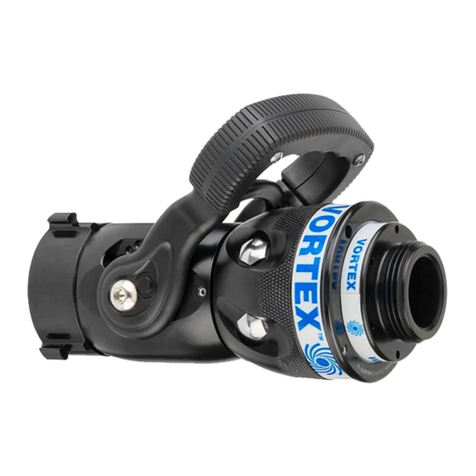
Task Force Tips
Task Force Tips Vortex 1.5" manual

Kidde
Kidde IG-55 Design, Installation, Operation, and Maintenance Manual with FM Approval
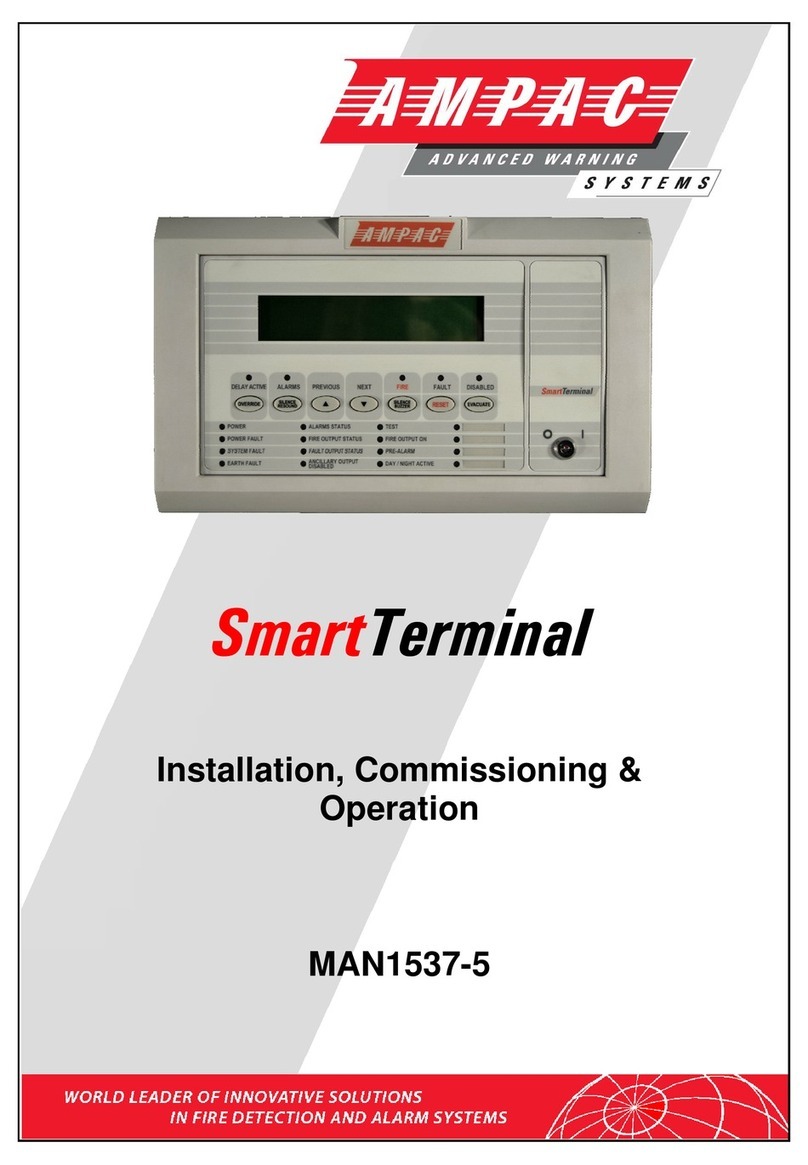
Ampac
Ampac SmartTerminal Installation, commissioning & operation
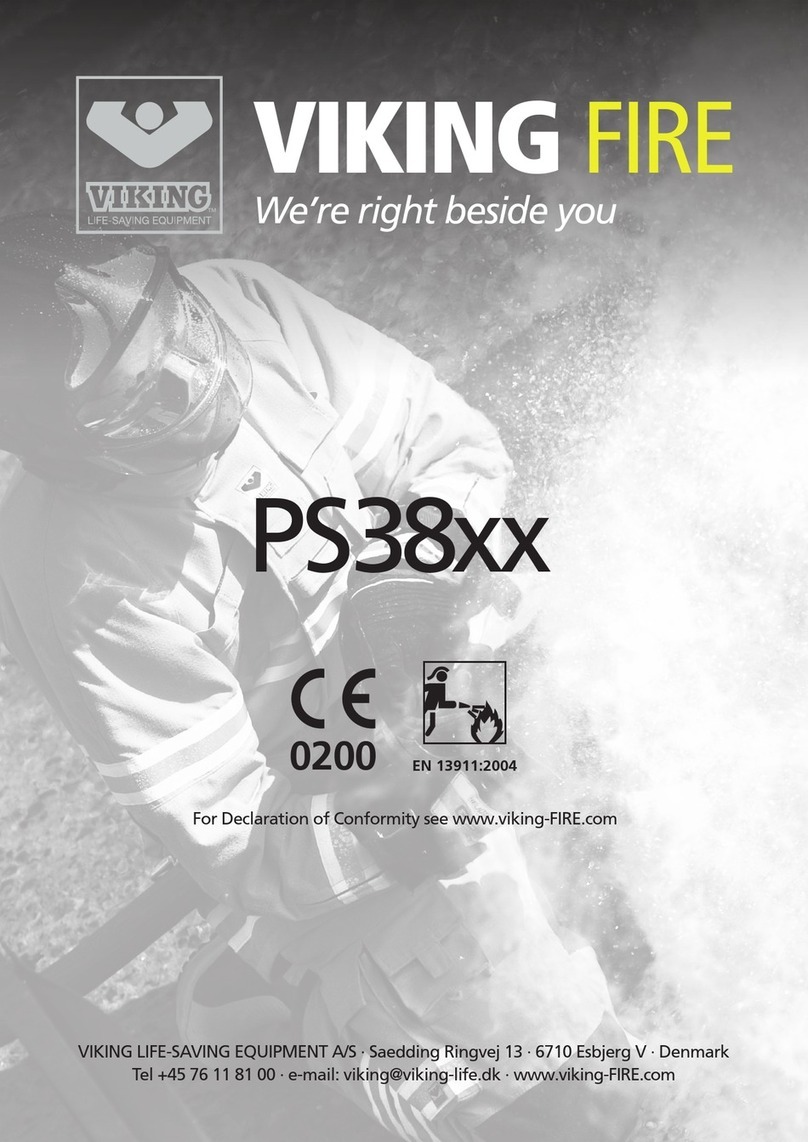
Viking
Viking PS38 Series manual
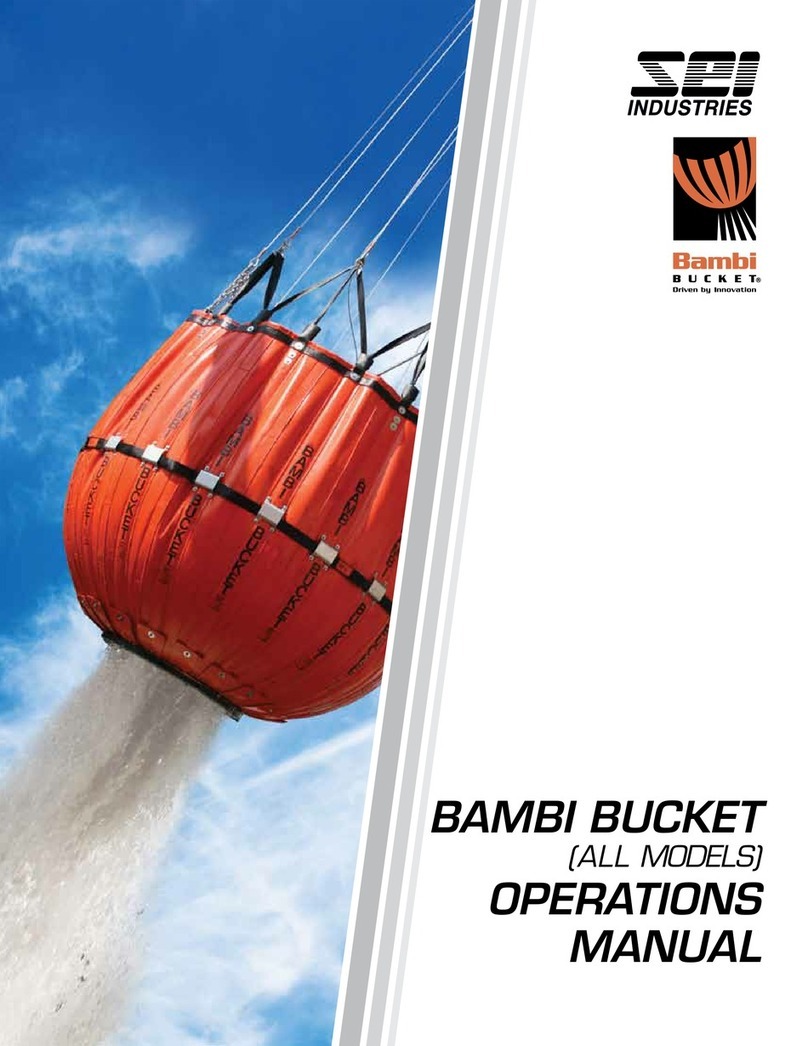
SEI Industries
SEI Industries 6072 Operation manual

